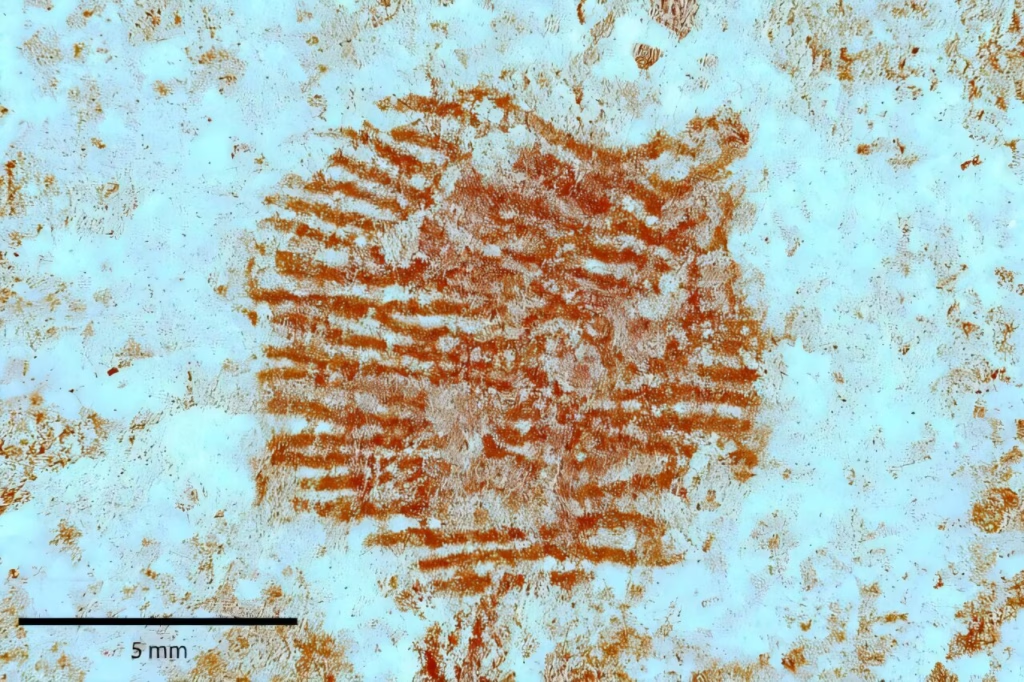A striking archaeological discovery in Spain may offer a rare glimpse into the symbolic world of Neanderthals. A quartz-rich pebble unearthed in a prehistoric rock shelter appears to bear a red mark that researchers believe might have been intentionally placed by a Neanderthal around 43,000 years ago—possibly as part of an abstract representation of a face.
If confirmed, this would suggest a level of symbolic thought and artistic expression not always attributed to our extinct human relatives.
A Red Dot and the Suggestion of a Face
The stone was discovered in the San Lázaro rock shelter near Segovia, Spain. Excavators noted a peculiar red mark on its surface, located in a spot that—together with the natural contours and grooves of the stone—evokes the image of a human face.

Researchers suggest that the mark may have been made by pressing a pigment-covered finger onto the stone. The pigment used is likely ochre, a natural clay-based red pigment known to have been used by early humans. Remarkably, this imprint may represent one of the oldest known adult fingerprints in the archaeological record.
Possibly the Oldest Painted Portable Object in Europe
According to Professor María de Andrés-Herrero of Complutense University of Madrid, who co-authored the study, the pebble was found in 2022, buried beneath a 1.5-meter layer of sediment believed to have been left by Neanderthal groups. The stone likely originated from the Eresma River, at least 5 kilometers from the site, and appears to have been intentionally selected—possibly for its shape, texture, and symbolic potential.
At a press conference, Spanish heritage official Gonzalo Santonja stated that the artifact may be the oldest painted portable object ever discovered in Europe, and potentially the only known piece of transportable art created by Neanderthals.

Evidence of Symbolic Thinking?
One key detail deepens the intrigue: the red pigment does not occur naturally within the shelter, indicating that it was deliberately brought to the site. The researchers argue that this, combined with the strategic placement of the pigment, rules out coincidence.
The study, published in the Journal of Archaeological and Anthropological Sciences, notes:
“The red mark is not randomly applied but positioned with a level of specificity that strongly suggests intentionality.”
“The stone’s appearance likely attracted attention, and the application of pigment reveals the actions of a mind capable of symbolization, imagination, and conceptual thought.”
The authors propose that the creation involved three cognitive processes often linked to art: mental image formation, deliberate communication, and the assignment of meaning.
One of the Oldest Known Abstract Human Face Representations?
Given its visual resemblance to a face, some archaeologists suggest this pebble may represent one of the earliest known examples of facial abstraction in human history. And if the fingerprint theory holds, it would also mark the earliest preserved adult fingerprint, likely from a male Neanderthal.
This discovery opens a new chapter in our understanding of Neanderthals—not just as tool-makers and hunters, but as beings capable of imagination, creativity, and symbolic thought. While more research is needed to confirm its full significance, this small red-marked stone could reshape how we view the origins of human artistic expression.
Cover Image Credit: David Álvarez-Alonso et al, More than a fingerprint on a pebble: A pigment-marked object from San Lázaro rock-shelter in the context of Neanderthal symbolic behavior, Archaeological and Anthropological Sciences (2025). DOI: 10.1007/s12520-025-02243-1





